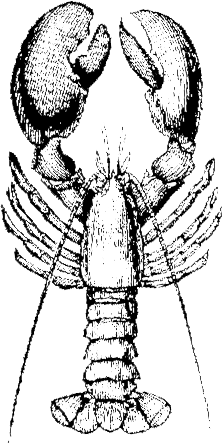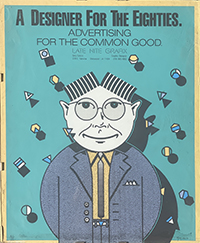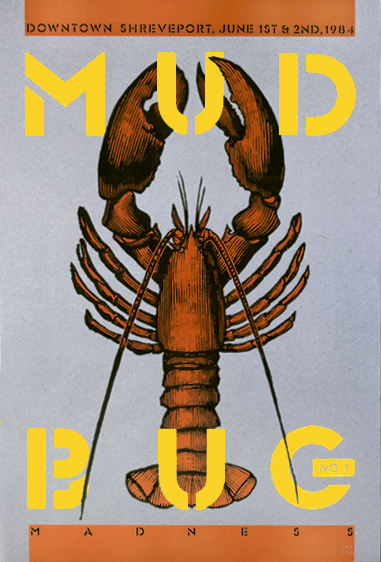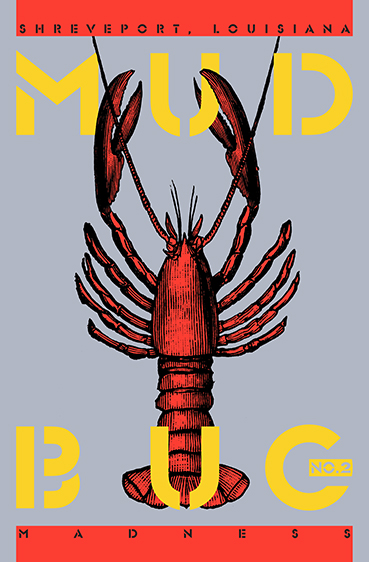When is a mudbug not a mudbug, but kinda is? (The story behind my “Mudbug Madness” poster)
In 1984, having recently left an ad agency and on my own, I put out my shingle as a freelance graphic designer and named my business “Late Nite Grafix”. (See the "About” page to find out the story behind the name of my business.) Soon, I was approached by the Shreveport Downtown Development Authority to create a poster for a new festival they were promoting to help bring people back to downtown Shreveport. They called the event “Mudbug Madness”.
I set about to create a poster. I wanted a very strong, graphic approach to the design. However, I also loved old woodcuts and engravings from the early 20th century and earlier. I hoped to combine a modern graphic design sensibility with an old woodcut or steel engraving of a crawfish…if I could find one.
At that time, before the internet, resources were fairly limited. I could go to the library and look through old books and maybe find what I was looking for, but then I wasn't sure how I would get the image out of the book, have it scanned, copied and enlarged so that I could then paste it into my mechanical. I was also concerned about figuring out the ownership of whatever I found. So, I turned to my old, tried and true “Animals: A Pictorial Archive From Nineteenth Century Sources. Copyright Free” from Dover Publications.
 Try as I might, I just couldn’t find an engraving of a crawfish. But I did find one of a lobster (See the b&w image to the left). The thing is, a lobster sort of looks like a crawfish but its claws are a lot larger. Going from a black and white blow-up of the Dover Publication lobster, I whittled on the lobster a bit. I shaved off what I felt like was a lot of material from the lobster’s claws.
Try as I might, I just couldn’t find an engraving of a crawfish. But I did find one of a lobster (See the b&w image to the left). The thing is, a lobster sort of looks like a crawfish but its claws are a lot larger. Going from a black and white blow-up of the Dover Publication lobster, I whittled on the lobster a bit. I shaved off what I felt like was a lot of material from the lobster’s claws.
I worked on the lobster quite a bit until I felt I had transformed it from a lobster into a mudbug or at least a mutant “mudlobsterbug”.
The image, along with the required copy containing the name and dates for the festival was finalized, shown to the client, approved and  then was off to the printer. Because this was the first year of the festival and the size of the crowd was not assured, the client only wanted a few hundred posters. Silkscreening was the best choice and Abbott Sign Company was the best printer. I had worked with them quite a bit as I was beginning my career in graphic design. In fact, they had printed a poster I designed to promote my business, Late Nite Grafix, after I went out on my own.
then was off to the printer. Because this was the first year of the festival and the size of the crowd was not assured, the client only wanted a few hundred posters. Silkscreening was the best choice and Abbott Sign Company was the best printer. I had worked with them quite a bit as I was beginning my career in graphic design. In fact, they had printed a poster I designed to promote my business, Late Nite Grafix, after I went out on my own.
I chose a poster size of 23" by 33". I picked out a premium paper stock called “Gray Flannel”. ( I believe the paper company was Stratmore or maybe Mohawk.) We printed it in three colors, yellow, warm red (one of my favorites) and black.
The client loved the poster. They quickly sold out of the initial run. We might have printed a second run but my memory is somewhat hazy after 40 years.
I thought I had dodged a bullet on the stand-in lobster engraving for a mudbug but was soon proven wrong. After winning some local & regional awards for my poster, and appearing in a couple of national publications, I was asked by a southern Louisiana ad club to come down and do a presentation of my design and advertising work. I was very proud and excited to be asked and I happily drove down with my buddy Dan Baldwin who had also been asked to make a presentation based on his copywriting and commercial producing skills.
We were told there would also be a crawfish boil. Arriving at the boil, we prepared for a good, old-fashioned Cajun crawfish boil. (“Preparing”, if you weren't actually cooking mostly meant drinking beer.) It was held outside at someone’s home, there were newspapers spread across the picnic tables, good Cajun music playing, ice-cold beer in the wash tubs and lots of crawfish preparing to give their lives in honor of the two pros from Shreveport. I was called over to the pot (an old plantation iron pot originally used for processing sugar cane) to haul out the first servings of crawfish. As I lifted up the strainer, to my surprise, it was not full of boiled crawfish but one big boiled lobster. Yes, the folks at the ad club decided to let me know in a not-too-subtle way that they knew a crawfish from a lobster and figured that the pros from Shreveport should know they knew.
We all had a good laugh, ate a lot of crawfish (and lobster), drank a bunch of beer and generally had a good time…some of it at my expense.
But I learned a good lesson. And over the years, it always nagged me that at that time I had not found a good engraving of a crawfish to work from. So, back in 2008, I created a second Mudbug Madness poster, based on my original design but modified enough to where it really looked more mudbug and less lobster…as I should have done the first time.
Below, you can see my original poster on the left and the 2008 modified one on the right. Of course, now, with the internet as vast as it is, finding an old woodcut or steel engraving of a crawfish would be much less of a problem. Oh well…
Mudbug Madness poster #1

Mudbug Madness poster #2

Everything you always wanted to know about Crawfish
Crayfish are freshwater crustaceans belonging to the infraorder Astacidea, which also contains lobsters. Taxonomically, they are members of the superfamilies Astacoidea and Parastacoidea. They breathe through feather-like gills. Some species are found in brooks and streams, where fresh water is running, while others thrive in swamps, ditches, and paddy fields. Most crayfish cannot tolerate polluted water, although some species, such as Procambarus clarkii, are hardier. Crayfish feed on animals and plants, either living or decomposing, and detritus.
The term "crayfish" is applied to saltwater species in some countries.
Terminology
The name "crayfish" comes from the Old French word escrevisse (Modern French écrevisse). The word has been modified to "crayfish" by association with "fish" (folk etymology). The largely American variant "crawfish" is similarly derived.
Some kinds of crayfish are known locally as lobsters, crawdads, mudbugs, and yabbies. In the Eastern United States, "crayfish" is more common in the north, while "crawdad" is heard more in central and southwestern regions, and "crawfish" farther south, although considerable overlaps exist.
The study of crayfish is called astacology.
In 1983, Louisiana designated the crayfish, or crawfish as they are commonly called, as its official state crustacean. Louisiana produces 100 million pounds of crawfish per year with the red swamp and white river crawfish being the main species harvested. Crawfish are a part of Cajun culture dating back hundreds of years. A variety of cottage industries have developed as a result of commercialized crawfish iconography.
Crayfish are eaten worldwide. Like other edible crustaceans, only a small portion of the body of a crayfish is eaten. In most prepared dishes, such as soups, bisques and étouffées, only the tail portion is served. At crawfish boils or other meals where the entire body of the crayfish is presented, other portions, such as the claw meat, may be eaten.
(All the above info from Wikipedia)
This is the part I never knew…
Research shows that crayfish do not die immediately when boiled alive, and respond to pain in a similar way to mammals. Then the stress hormone cortisol is released and this leads to the formation of lactic acid in the muscles, which makes the meat taste sour. Crayfish can be cooked more humanely by first freezing them unconscious for a few hours, then destroying the central nervous system along their abdomen by cutting the crayfish lengthwise with a long knife down the center of the crayfish before cooking it.
(And this info is also from Wikipedia)
